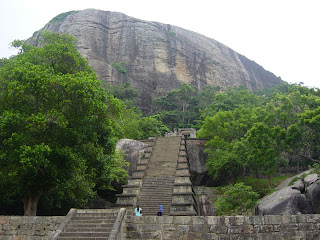
The rock fortress complex of Yapahuwa is situated in the Wayamba province of Sri Lanka. Yapahuwa served as the capital of Sri Lanka in the latter part of the 13th century (1273-1284). Built on a huge, 90 meter high rock boulder in the style of the Sigiriya rock fortress, Yapahuwa was a palace and military stronghold against foreign invaders.
The palace and fortress were built by King Buvanekabahu I (1272-1284) in the year 1273. Many traces of ancient battle defences can still be seen, while an ornamental stairway, is its biggest showpiece. On top of the rock are the remains of a stupa, a Bodhi tree enclosure, and a rock shelter/cave used by Buddhist monks, indicating that earlier this site was used as a Buddhist monastery, like many boulders and hills in the area. There are several caves at the base of the rock. In one of them there is a shrine with Buddha images. One cave has a Brahmi script inscription. At the southern base of the rock there is a fortification with two moats and ramparts. In this enclosure there are the remains of a number of buildings including a Buddhist shrine. There is a also a Buddhist temple called Yapawwa Rajamaha Vihara built during the Kandyan period.
The Tooth Relic was brought from Dambadeniya and kept in the Tooth Temple built for the purpose at the top of the third staircase. The relics were carried away from the temple here to South India by the Pandyas, and then recovered in 1288 by Parakkramabahu III (1287-1293), who temporarily placed them in safety at Polonnaruwa.
Location: 4 km southeast of the town and railway station of Maho, midway between Kurunegala and Anuradhapura.
The original name of this Buddhist Heritage site is Yapawwa though now often called as Yapahuwa which is a kind of distortion of its genuine etymological sense.
After the fall of the great city of Polonnaruwa, the Kandyan kings fled to a succession of inaccessible crags, bearing with them the sacred tooth relic of the Buddha. One of them was Yapahuwa, a huge, yet little-visited rock fortress a little way off the Kurunegala-Anuradhapura road, and one of the great architectural sites of the island. This early 13th century stronghold is reminiscent of Sigiriya, a massive granite outcrop, set in a shady location, and rising 100m above the plains below. King Bhuvanekabahu I developed Yapahuwa, building a palace and a temple, which housed the famous tooth relic for 11 years. After Yapahuwa was abandoned, Buddhist monks took it over and still remain today. Yapahuwa is worthy of a visit as it is relatively quick to see, interesting and beautiful. Although not as significant as other Cultural Triangle sites it does have a special individual charm.




